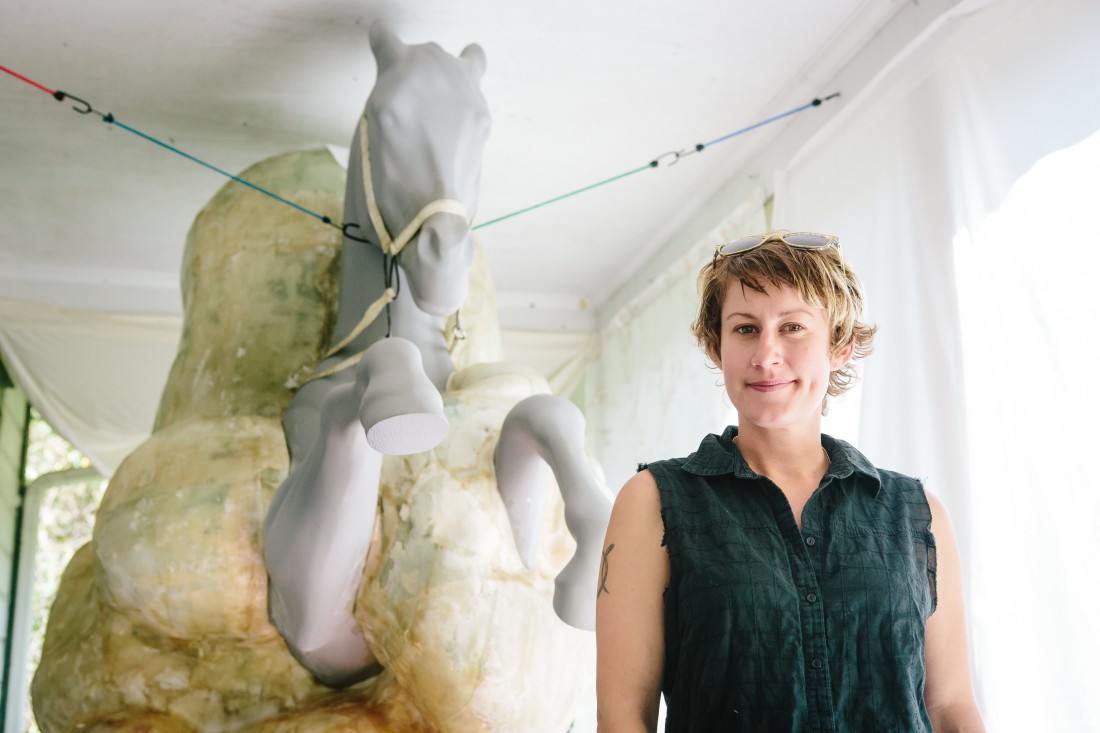By Rena Lindstrom
The 2nd Terrain Biennial brings art to the people, literally where they live, in the front yards of neighborhoods. In this case, it’s in West Asheville, where a neighbor walking the dog can be surprised, challenged and delighted by Nora Hartlaub’s oversized equestrian statue at 1 Mountain Terrace, beginning Sunday, Aug. 23.
The Terrain Biennial originated in 2011 with Sabina Ott, an artist, curator and professor of art at Columbia College Chicago. Ott was looking for a fun way to actively engage the local artistic community. She was aware of the growing proliferation of the artist-run exhibition spaces. “I’m intrigued by accidental audiences,” she says, “and want art to be more accessible.” Ott curated the first exhibitions in front yards of artists in her Oak Park neighborhood. By 2013, she initiated the first Biennial.
“It’s real art,” Ott says. “It sits in a place it’s not supposed to be and has a conversation with house, street, neighbor. The atmosphere is not mediated by the traditional gallery setting, which can be chilly and inhospitable.”
Ott asked colleague Ron Laboray, an artist and assistant professor of painting and drawing at Western Carolina University, to curate and host a portion of the 2015 event in Asheville. Laboray turned to Hartlaub, who recently received her MFA at WCU under Laboray’s mentorship.
Hartlaub’s work builds upon her experience growing up in the world of horses, riding and caring for them. In a recent piece, “The Collection,” the artist encased her childhood model horse collection in abstracted Crayola-colored forms. “It’s my ongoing investigation into how nostalgia influences our perception and how that is reflected in our basic social structure,” she says. “The Collection” represents the miniaturized, intimate and personalized relationship between the self and the concepts of gender, power, memory and nostalgia. “I’m working on the question and the answer at the same time,” says Hartlaub.
“NC Equestrian Statue” hijacks the traditional rider-on-horseback statue as a totem of imperial power often installed on the lawns of public institutions. Hartlaub throws that assumption of innate masculine power out of balance by encasing the cultural symbol in an abstracted, undulating globular mass made of carved foamboard and fiberglass: an alien body that appears to be consuming hero and horse. “This abstracted form is an echo of an actual male body, as well as a representation of the abstract nature of power,” Hartlaub says. “I’m softening the image of the supermasculine rider, turning it into a blob. It’s subversive.”
The installation is not, however, about a woman artist claiming her space in the malecentric art world. Rather, it is about the rigid state power, specifically that of current North Carolina legislators who have abstracted the actual bodies of the women whose health and safety they claim to want to protect. This perceived duty, says Hartlaub, is inspired by a nostalgic attachment to women as homemaker, the center of the family, isolated and privatized and sanitized.
“There is no connection to the very real manifestation of their lawmaking as it affects the real body of women — the messy, viscous, sticky, reproducing body women live in all day every day,” says Hartlaub. “My body.”
“The biennial project shows the potential of art to connect us where we live,” Laboray says. “Hartlaub begins with heavy concepts and moves into the form. The subversive form addresses the ideas with humor. She is working with very elemental ideas reflective of our shared experience and values. She is engaging the community with her characteristic original, thoughtful, witty take on the subject.”
Talking about the movement of the Terrain Biennial beyond Chicago, Ott says, “Every individual place is connected to other individual places. It’s a kind of rhizome model. The pinpoint is already set.” This shared communication sparks on a single day across the world as this year’s event opens in 12 settings — including Milwaukee and Los Angeles;Viborg, Denmark and Phnom Penh, Cambodia — on Aug. 23.
According to Hartlaub, the invitation to participate in the 2015 Biennial comes at a pivotal time in her career. “It’s really exciting to have this opportunity,” she says. “I can take the work to a new level, to expand my exploration of the visual nature of these concepts of gender, power, memory and nostalgia from the personal and intimate to the monumental, public and collective.”
As Laboray puts it, “This exhibition is just the beginning for the Terrain Biennial in Asheville.”
WHAT: 2015 International Terrain Biennial
WHERE: Local installation at 1 Mountain Terrace, West Asheville
WHEN: Sunday, Aug. 23, to Wednesday, Sept. 30. After the exhibit closes, projects can be seen at terrainexhibition.tumblr.com






http://bucklandpubliclibrary.org/robertomjunior/e14ed-01389-72.htmlティファニー ブレスレット バイザヤード,少女時代 ティファニー 目,ニナリッチ 店舗
ティファニー 食器 引き出物,ティファニー ピアス シルバー,ニナリッチ 時計 リボン http://www.leadingcomputerservices.com/robertomjunior/e630e-21390-79.html
http://www.webspy.co.za/robertomjunior/d519a-51386-51.htmlティファニー 婚約指輪 相場,ラブティファニー NS,ニナリッチ 香水 マカロン
少女時代 ティファニー 画像,ティファニー ピアス シルバー,ニナリッチ ハンカチ http://cardinalph.co.za/wp-fany/cb557-11383-32.html